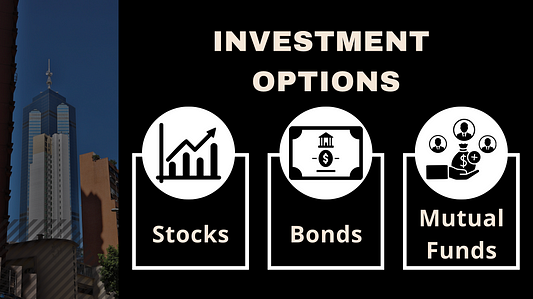A beginner’s guide to investment choices, risks, and tips for financial success
Congratulations on deciding to dip your toes into the exciting world of investing.
Investing can be a powerful tool to grow your wealth over time, but it is important to understand the basics before you get started.
This article will provide an easy-to-understand overview of different investment options, like stocks, bonds, and mutual funds.
We will also look at the concepts of risk and return and offer some practical guidance for beginners.
Stocks
We can start with the most familiar investment option: stocks. When you buy a stock, you are essentially buying a piece of a company.
Imagine you own a small slice of your favourite pizza place, and every time they sell a pizza, you get a tiny piece of the profit. That is how stocks work.
The truth is that stocks can be volatile. Their value can swing up and down— but this volatility can also mean big rewards.
Over the long term, stocks have historically provided higher returns compared to other investment options.
Therefore even if you feel a bit uneasy when you see your stock’s value drop, remember that investing is a marathon, not a sprint.
Bonds
If stocks are the daredevils of the investment world, bonds are the cautious planners.
When you buy a bond, you are essentially lending money to a company or government.
In return, they promise to pay you back with interest over a specified period.
Bonds are generally considered safer than stocks because they offer more stability.
However, the trade-off is that their returns are usually lower. Think of bonds as the slow and steady tortoise in the investment race.
They will not make you rich overnight, but they can provide a reliable source of income and help preserve your capital.
Mutual Funds
Moving onto mutual funds, these are like the investment equivalent of a buffet.
When you invest in a mutual fund, you are pooling your money with other investors to buy a diversified portfolio of stocks, bonds, or other assets.
The beauty of mutual funds is that they spread the risk. If one company does not do well, it is not the end of the world because your money is invested in many others.
This diversification can help reduce the roller-coaster feeling that often comes with individual stocks.

Risk And Return
Understanding risk and return is crucial in the investing world. It is crucial that you understand this before you start your investment journey.
Risk:
This is the chance that you might lose some or all of your investment. The different types of risks include:
- Market risk (related to overall market movements)
- Company-specific risk (related to the performance of a specific)
- Inflation risk (your money losing value over time)
Return:
This is the reward you expect to receive for taking on risk.
Returns can come from:
- Capital appreciation (your investment increasing in value)
- Income (like dividends from stocks or interest from bonds)
Usually, the higher the potential return, the higher the risk you will likely face.
Stocks tend to offer higher returns but come with more risk.
Bonds provide lower returns but are generally less risky.
Mutual funds offer a balance, depending on their asset allocation.
Tips For Beginner Investors
Now that you have a basic understanding of investment options, here are some practical tips for beginners:

Step 01: Start with a plan
Before investing a single penny, outline your financial goals and risk tolerance.
Are you saving for retirement, a new home, or a dream vacation? Knowing your goals will help shape your investment strategy.
Step 02: Diversify your portfolio
Do not “put all your eggs in one basket” — is a saying that is commonly used when it comes to investing.
A well-diversified portfolio spreads risk and can help you weather market fluctuations more effectively.
Step 03: Do your homework
Research the investments you are interested in. Understand the companies or funds you are investing in and their track record.
Step 04: Stay in it long term
Investing is not a get-rich-quick scheme. It is about patiently growing your wealth over time.
Avoid making impulsive decisions based on short-term market fluctuations.
Step 05: Stay informed
Keep up with financial news and stay informed about your investments.
However, it is also important to not get overwhelmed by every twist and turn in the market.
Step 06: Consider professional advice
If you are unsure about where to start or need guidance, consider consulting a financial advisor.
They can help you create a tailored investment plan that suits your needs (based on what you want to achieve).
Step 07: Automate your investments
Setting up automatic contributions to your investment accounts can help you stay disciplined and consistent with your saving and investing habits.
Step 08: Do not fear failure
Not every investment will be a winner, and that is okay.
Learn from your mistakes and use them as stepping stones to better financial decisions in the future.

In conclusion, investing can be a powerful tool for building wealth over time, but it’s not without its challenges.
Stocks, bonds, and mutual funds are just a few of the options available to you.
Remember that risk and return go hand in hand, and the key is to find a balance that aligns with your goals and comfort level.
Take that first step, start your investment journey, and watch your wealth grow over time.
Happy investing!
If you would like to know more about finance and investing, feel free to check out the following list:
Finance and Investing
Edit descriptionmedium.com
As always, if you have any other questions or thoughts, please feel free to add them to the responses section.
This article is for informational purposes only. It should not be considered Financial or Legal Advice. Not all information will be accurate. Consult a financial professional before making any major financial decisions.

